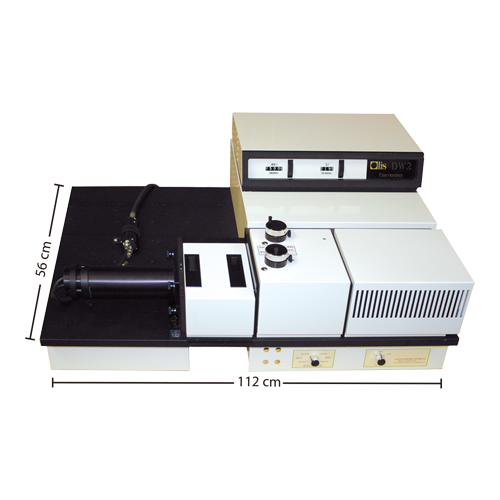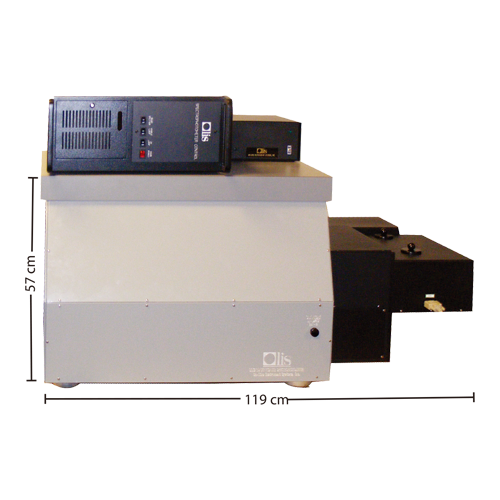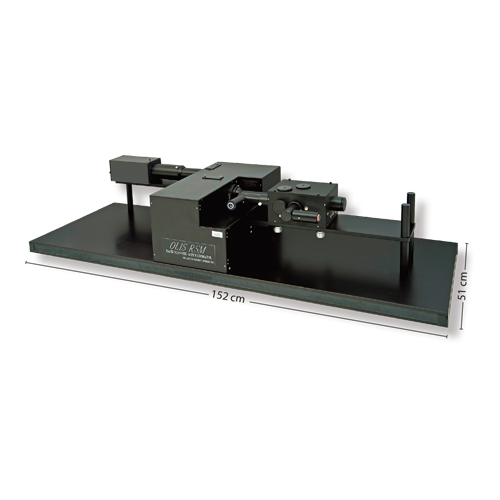Imagine getting exactly the right absorbance reading on suspensions as widely disparate in turbidity as the five samples shown.
The polystyrene particles used to create these suspensions have zero absorbance. Would your spectrophotometer return 0.0 AU as the answer for all five?
No. For decades, reliable, accurate absorbance studies have been dependent upon thehomogeneity and clarity of the sample. Turbid samples produce apparent high absorbances, not the correct answer.
For decades, spectrophotometrically working with turbid suspensions has proved elusive, because themeasurement beam is scattered in all directions; only a fraction of it passes through the sample to the detector. “Apparent high absorbance” is the result, as these examples show.
Scatter Does Not Matter! Only Sample Absorbance Does.
The CLARiTY allows you to rethink your possibilities.
Results from four popular and respected spectrophotometers compared with the Olis CLARiTY 1000
The sample was the most concentrated suspension of polystyrene particles in water (about 108 of the 1 micron particles/mL H2O) as shown on page 2. Recall, polystyrene particles do not absorb light, so the correct answer is 0.0 AU.
The CLARiTY gets zero absorbance, give or take 0.01 AU. As these and other data will show, scatter does not matter to the CLARiTY,including the UV, where even the “goldstandard” cannot handle the scatter correctly.
主要型号
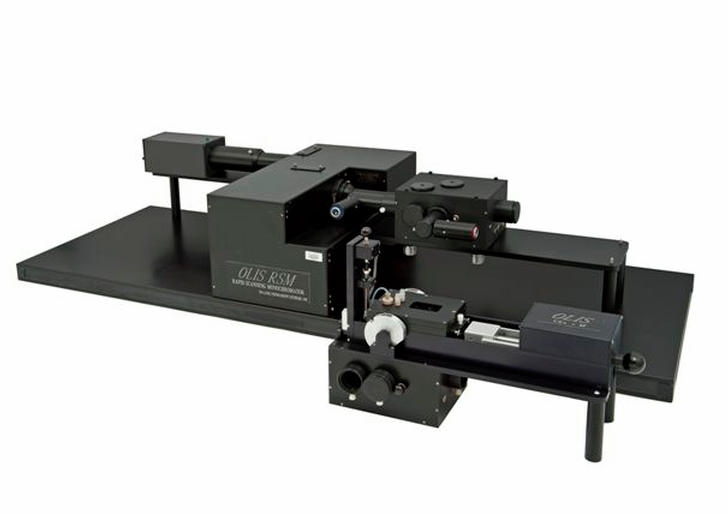
For bioenergetics & drug discovery breakthroughs.
Subsecond spectral acquisition rates, nanomolar sensitivity, and complete immunity to scatter.
The “fondest dream” for investigators working on enzyme kinetics, protein expression, blood research, microbe metabolism, algae photosynthesis, and more. Easily repurposed for stopped-flow spectrophotometry.
Technical Specifications:
- Collect ‘spectral videos’ at rates to 100 scans/ second
- When rapid-scanning, scans are 38, 77, 154, or 231 nm wide with corresponding spectral resolutions of 0.3, 0.6, 1.2, or 1.8 nm
- When not rapid-scanning, scans can be of arbitrary length and selected spectral resolution
- True sample and reference (dual beam) acquisition with two photomultiplier tubes
- Spectral Range = 240 - 800 nm
- Detection limit of 5 x 10-5 AU
- Reconfigurable to the OLIS DSM 1000 CD and the OLIS RSM 1000 for stopped-flow and flash photolysis studies
- Footprint 60" x 20" x 14"
Available enhancements include fluorescence detection, oxygen monitoring, actinic source, computerized shutter, ion electrodes, novel DSPCs, automatic titrator, and stopped-flow.
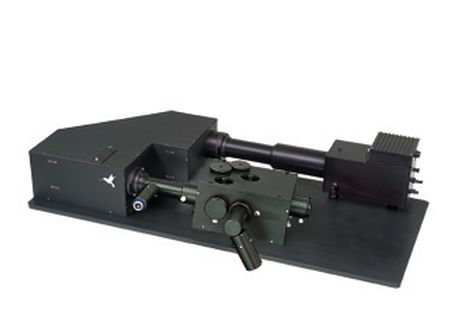
Technical Specifications:
- First choice when neither rapid-scanning nor NIR are required
- Spectral Range = 240 - 800 nm
- Capture slow ‘spectral videos’ of metabolism and other processes
- Spectra at rates to 20 nm/ second
- Fixed slit widths during scan
- True sample and reference (dual beam) acquisition by two photomultiplier tubes
- Detection limit of 8 x 10-6 AU
- Reconfigurable to the OLIS DSM 20 CD
- Footprint 30” x 30” x 20”
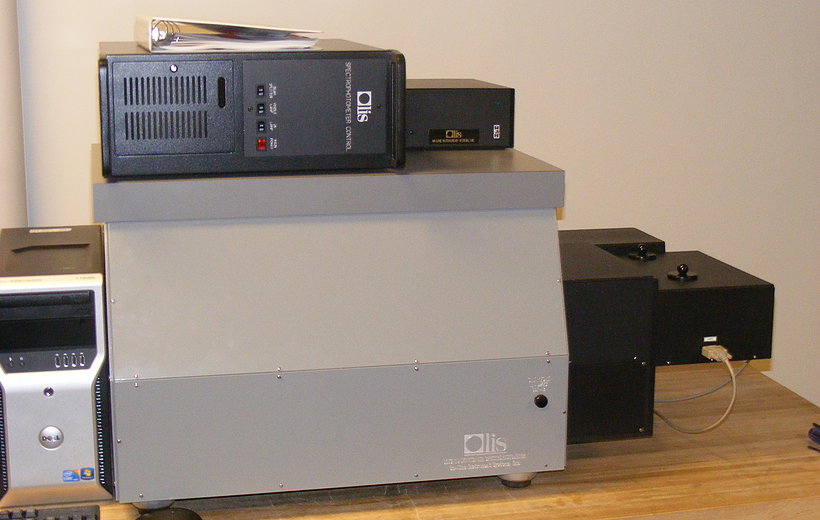 For nanoparticles & pigment development
Nanomolar sensitivity, complete immunity to scatter, and NIR ready.
The choice for gold & silver nanoparticles, carbon nanotubes, fruit, meat, plant tissue, and more.
Easily repurposed as a premium UV/Vis/NIR (185-2600 nm) for absorbance and/or circular dichroism.
Specifications:
For nanoparticles & pigment development
Nanomolar sensitivity, complete immunity to scatter, and NIR ready.
The choice for gold & silver nanoparticles, carbon nanotubes, fruit, meat, plant tissue, and more.
Easily repurposed as a premium UV/Vis/NIR (185-2600 nm) for absorbance and/or circular dichroism.
Specifications:
- Spectral Range = 240 - 800 nm
- Scan at rates to 20 nm/ second
- Fully adjustable slit widths during scan
- Detection limit of 8 x 10-6 AU
- Reconfigurable to the OLIS DSM 17 CD and the OLIS 17 UV/Vis/NIR
- Footprint 47” x 27” x 19”
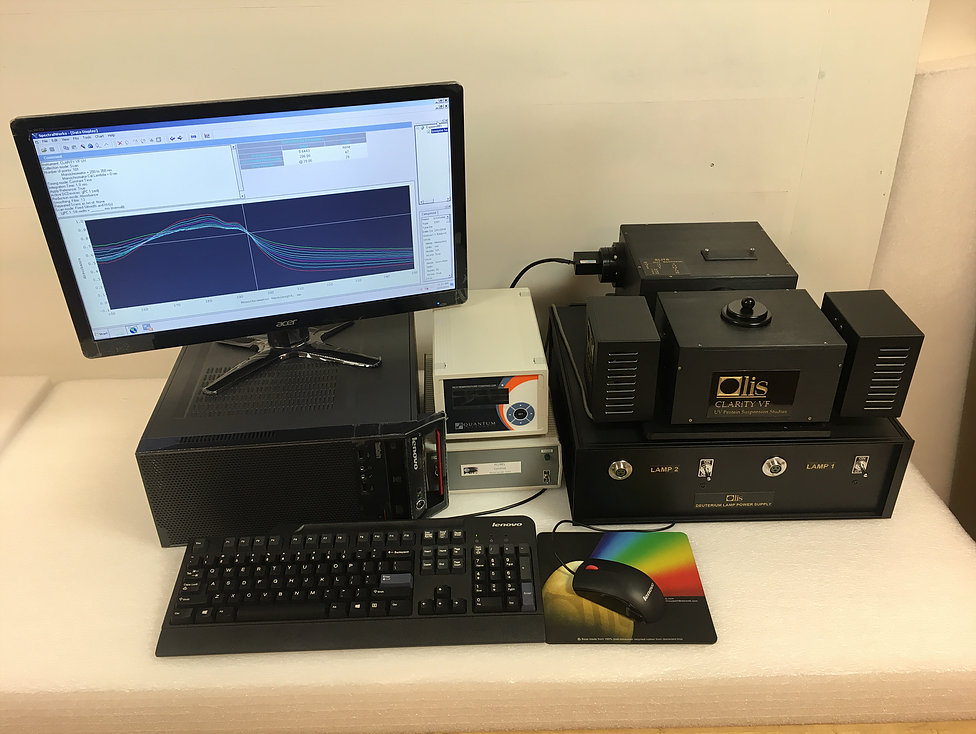
Developed as a Pump-Probe spectrometer, the CLARiTY VF is now offered as our least expensive scanning UV, Vis, or full range UV/Vis CLARiTY.
Your VF will be produced with one lamp, two lamps, or LEDs, as is best for the intended use.
- For absorbance protein studies: UV, 240-400 nm (deuterium lamp).
- For the absorbance electron transport region: Vis, 400-600 nm (tungsten lamp).
- For absorbance UV/Vis scanning: 240-870 nm (deuterium and tungsten lamps).
- For fluorescence and Pump-Probe work, wavelength specific LEDs are used instead or of in addition to the steady-state lamp. LEDs are the preferred illumination source when rapid on/off cycling is required
- Single grating monochromator with scan rates to 20 nm/ second
- Exquisitely sensitive photon counting detector, full range 230-870 nm
- Integrating cavity up to 8 mL to be used for direct sample introduction or by means of a 1 mL or 150 uL test tube.
Specify optical train for absorbance or fluorescence:
Absorbance = light source, monochromator, sample, detector
Fluorescence = light source, sample, monochromator, detector
CLARiTY VFA: For cells, mitochondria, algae, and other biological systems. Scanning monochromatic light for absorbance & fluorescence excitation with fixed lambda emission.
CLARiTY VFL: For inorganics, organics, nanoparticles, and more. Shuttered broadband light (through optional filter) for absorbance & excitation, with scanning emission.

UV/Vis 'Diode Array' for solutions & suspensions
Technical Specifications:
- Wavelength range is 240 nm – 760 nm with 2 nm resolution
- Scan rate is a function of light level, nominally 1-10 spectra/ second
- Single beam detection
- Immunity to scatter
- Nanomolar sensitivity
- Pulsed Xenon source with integrated shutter
- Entire sample is immersed in the measurement beam obviating the need for positioning or orientation of the sample
- Ultra low stray light single monochromator with 75 mm focal length
- Backlit CCD with 2048 pixels
- Integrating cavity of 1 or 8 mL capacity
- Footprint: 21” x 21” x 6”

